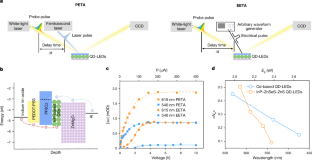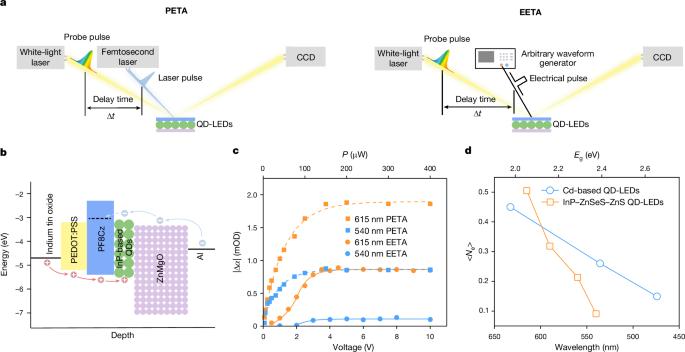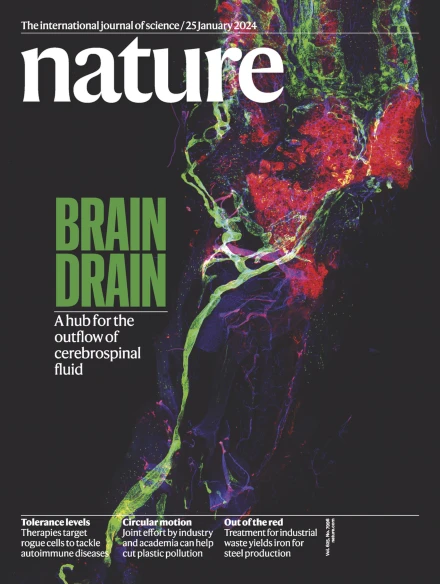通过控制电子注入和泄漏实现高效的绿色 InP 基 QD-LED
IF 50.5
1区 综合性期刊
Q1 MULTIDISCIPLINARY SCIENCES
引用次数: 0
摘要
基于绿色磷化铟(InP)的量子点发光二极管(QD-LED)仍然存在效率低和工作寿命短的问题,这对实现完全无镉的 QD-LED 显示和照明提出了严峻的挑战1,2,3。遗憾的是,造成这些局限性的因素仍不明确,因此也没有明确的器件工程指导原则。在这里,我们利用电激发瞬态吸收光谱发现,最先进的绿色无镉 QD-LED (普遍采用 InP-ZnSeS-ZnS 核-壳-壳结构)的低效率源于 ZnSeS 中间层,因为它施加了高注入势垒,限制了电子浓度和陷阱饱和度。我们通过实验和理论证明,用加厚的 ZnSe 中间膜取代目前广泛使用的 ZnSeS 中间膜,可以同时改善电子注入和抑制泄漏,从而使外部量子效率峰值达到 26.在波长为 543 纳米的绿色 InP 基 QD-LED 中,当初始亮度为 1,000 cd m-2 时,峰值外部量子效率为 26.68%,T95 寿命(亮度下降到初始值 95% 的时间)为 1,241 h,分别比之前的最佳值高出 1.6 倍和 165 倍3,4。本文章由计算机程序翻译,如有差异,请以英文原文为准。


Efficient green InP-based QD-LED by controlling electron injection and leakage
Green indium phosphide (InP)-based quantum dot light-emitting diodes (QD-LEDs) still suffer from low efficiency and short operational lifetime, posing a critical challenge to fully cadmium-free QD-LED displays and lighting1–3. Unfortunately, the factors that underlie these limitations remain unclear and, therefore, no clear device-engineering guidelines are available. Here, by using electrically excited transient absorption spectroscopy, we find that the low efficiency of state-of-the-art green cadmium-free QD-LEDs (which ubiquitously adopt the InP–ZnSeS–ZnS core–shell–shell structure) originates from the ZnSeS interlayer because it imposes a high injection barrier that limits the electron concentration and trap saturation. We demonstrate, both experimentally and theoretically, that replacing the currently widely used ZnSeS interlayer with a thickened ZnSe interlayer enables improved electron injection and depressed leakage simultaneously, allowing to achieve a peak external quantum efficiency of 26.68% and T95 lifetime (time for the luminance to drop to 95% of the initial value) of 1,241 h at an initial brightness of 1,000 cd m–2 in green InP-based QD-LEDs emitting at 543 nm—exceeding the previous best values by a factor of 1.6 and 165, respectively3,4. Replacing ZnSeS with a thickened ZnSe layer in green InP-based QD-LEDs improves the efficiency and lifetime, boosting electron injection and reducing leakage, enabling 26.68% external quantum efficiency and 1,241 h T95 lifetime.
求助全文
通过发布文献求助,成功后即可免费获取论文全文。
去求助
来源期刊

Nature
综合性期刊-综合性期刊
CiteScore
90.00
自引率
1.20%
发文量
3652
审稿时长
3 months
期刊介绍:
Nature is a prestigious international journal that publishes peer-reviewed research in various scientific and technological fields. The selection of articles is based on criteria such as originality, importance, interdisciplinary relevance, timeliness, accessibility, elegance, and surprising conclusions. In addition to showcasing significant scientific advances, Nature delivers rapid, authoritative, insightful news, and interpretation of current and upcoming trends impacting science, scientists, and the broader public. The journal serves a dual purpose: firstly, to promptly share noteworthy scientific advances and foster discussions among scientists, and secondly, to ensure the swift dissemination of scientific results globally, emphasizing their significance for knowledge, culture, and daily life.
 求助内容:
求助内容: 应助结果提醒方式:
应助结果提醒方式:


